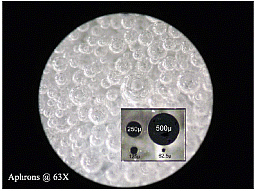This project has yielded a greater understanding of how aphron drilling fluids function to reduce lost circulation in gas and oil reservoirs without deleterious effects on productivity, thereby promoting acceptance of aphron drilling fluids as a cost-effective alternative to underbalanced drilling. Greater acceptance of the technology could result in enhanced natural gas production and reduced drilling costs, which will result in additional supplies of reasonably-priced fossil fuels for the American consumer. The project has provided new insights into the construction of aphrons and their behavior in drilling fluids, facilitating further improvements in their design.
This project includes two major efforts. Phase I was designed to develop a comprehensive understanding of how aphrons behave at elevated pressures and temperatures, particularly with respect to the effects of pressure on bubble size distribution and the manner in which they may create a minimally damaging seal in a permeable/fractured formation. This portion of the project was aimed at developing evidence for the ways in which aphrons behave differently from ordinary surfactant-stabilized bubbles, providing minimally damaging seals of permeable and fractured formations at the elevated pressures and temperatures encountered in drilling operations.
Phase II focused on the characterization of aphron-based drilling fluids. The optimization of drilling fluid formulation/method of aphron generation was investigated by looking at aphron microstructure and aphron drilling fluid performance. The flow properties of aphron drilling fluids were measured as well as the ability of aphron-based drilling fluids to seal permeable and fractured formations under simulated downhole conditions. Part of the project was dedicated to extensive sealing and formation damage testing of aphron-based drilling fluids, including scale-up tests under simulated downhole drilling conditions.
Results:
Aphrons are generated by natural entrainment at the surface of 12 to 15 vol % air in a surfactant-stabilized, highly shear-thinning fluid. Very soon after they are created, the oxygen is scavenged by one of the components in the fluid, leaving the aphrons with a core of nitrogen. Some of these aphrons can survive downhole pressures of at least 27.3 MPa (4000 psig), though the number of visible aphrons at that pressure may be small, and the survivors may have a limited life. Compression of aphrons initially results in volume reduction that is inversely proportional to the absolute pressure. Over time, they shrink further at a rate that depends on the surface area of the bubble, the rate at which the fluid was compressed, the level of shear (if the fluid is flowing), the concentration of nitrogen in solution and the chemical composition of the fluid. Maximum longevity at a given pressure is obtained with bubbles several hundred microns in diameter that are compressed rapidly and subjected to minimum shear. When the bubbles reach a critical minimum size -- 25 to 50 µm diameter -- they undergo a structural change that leads to their collapse (if the fluid is not saturated with nitrogen), and the aphrons vanish.
Aphron drilling fluids can control fluid invasion into formations with permeabilities as high as 80 darcy. Three mechanisms are involved. First, driven by a pressure differential and high shear rate, aphrons travel much faster than the base fluid and concentrate at the fluid front. Comminution of the aphrons by shear produces bubbles of a size similar to the openings in the rock, which can serve to bridge the openings. Second, particulates in the mud form a microgel network. Bridging by aphrons and particulates, coupled with radial flow of the mud into the formation, decreases the shear rate dramatically; this enables the third element, namely the viscosity of the very-high-LSRV base fluid, to build quickly to such high levels that the fluid almost stops.
Aphron drilling fluids also protect producing formations by minimizing loss of permeability (formation damage), first through the excellent compatibility of the drilling fluids with produced fluids, and second through the lack of affinity of aphrons for each other and for mineral surfaces.
The results obtained in this work demonstrated how and to what extent aphron drilling fluids reduce whole mud loss and minimize collateral damage to high-permeability porous media. Consequently, the industry can now utilize this technology with greater confidence to drill oil and gas wells and, by doing so, recover the hydrocarbons more economically.




